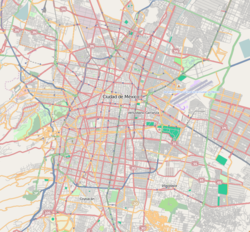Tacubaya metro station
Mexico City metro station From Wikipedia, the free encyclopedia
Tacubaya is a station on Lines 1, 7 and 9 of the Mexico City Metro system.[2][3] It is located in the Miguel Hidalgo borough, west of the city centre.[2] In 2019, the station had a total average ridership of 85,800 passengers per day, making it the fifth busiest station in the network.[4] Since 9 November 2023, the Line 1 station has remained closed for modernization work on the tunnel and the line's technical equipment.[5]
Name and pictogram
The station takes its name from the neighborhood it is located in: Tacubaya. The origin of this zone of the city can be traced back to an Aztec settlement, which back then was at the edge of Lake Texcoco. The name Tacubaya is a Spanish barbarism that derived from the Nahuatl Atlacuihuayan, that means "where water joins".[2]
Therefore, the station pictogram represents a water bowl, that also resembles the glyph of the Aztec settlement of Tacubaya found at the Codex Mendoza.[2]
History
Summarize
Perspective
Service at this station began on 20 November 1970, when Line 1 was expanded westwards from Juanacatlán to Tacubaya.[6] On 22 August 1985, Metro Tacubaya became a transfer station, when the second stretch of Line 7 was inaugurated, from Auditorio to Tacubaya.[7] In 1988, Line 9 was connected to the station as part of the final stretch of Line 9, inaugurated on 29 August 1988, going from Centro Médico to Tacubaya, thus becoming the western terminus of the line.[8]
According to earlier plans for the metro, Line 9 was supposed to be extended towards Observatorio. This is the reason why on Line 9 platforms of Tacubaya signs stating that the station is a provisional terminal can be seen since its opening in 1988. In 2018, the Sistema de Transporte Colectivo announced plans to complete this expansion from Tacubaya to Observatorio.[9] Mexico City government announced shortly after that no works would be done during 2019; and as of early 2020, works still have not been started.[10]
March 2020 train crash

On March 10, 2020, at about 23:37 local time (05:37 GMT), two trains crashed while both were going towards Observatorio station. The first train, No. 38, was parked at Tacubaya's platform when it was hit by another train, No. 33, that came in reverse at 70 kilometers per hour (43 mph).[11] According to official reports, 1 person died and 41 were injured,[12] all inside train No. 33; people in train No. 38 were evacuated moments before the crash.[11] Observatorio, Tacubaya and Juanacatlán stations were closed temporarily for repairs.[13] Authorities from the Sistema Transporte Colectivo Metro believe the crash was caused due to a failure in the train systems coupled with a 7-degree slope that propelled train No. 33 for a kilometer (0.62 mi),[14] that occurred after performing a parking maneuver at Observatorio station.[11]
2024 stabbing attack
On 19 November 2024, a man stabbed four people at the Line 7 platforms. The attacker was arrested.
General information
The station was built on many levels, in order to accommodate the connecting lines. It has a maze of long, wide corridors between the lines' platforms, which are equipped with escalators. This station's exits connect with many zones of Tacubaya neighborhood, such as Parque Lira, a local market and the offices of the Miguel Hidalgo borough administration.[15]
Metro Tacubaya has facilities for the handicapped, four cultural displays, as well as a medical module and a cyber center where users can access internet through a computer; both services are free. The mural Del códice al mural by Guillermo Ceniceros can be found inside the station in Line 1 platforms.[2]
The station serves the neighborhood of the same name. It was in this area of Mexico City where the French pastry chef had his shop that was damaged in 1828, an incident that lead to the Pastry War a decade later.
Ridership
Summarize
Perspective
|
| ||||||||||||||||||||||||||||||||||||||||||||||||||||||||||||||||||||||||||||||||||||||||||||||||||||||||||||||||||||||||||||||||||||||||||||||||||||||||||||||||||||||||||||||||||||||||||||||||||||||||||||||||||||||||
Nearby
- Parque Lira, public park.
- Museo Casa de la Bola, museum.
- Museo Nacional de Cartografía, museum of cartography.
- Alameda de Tacubaya, public plaza.
Exits
Line 1
Line 7
- Doctora and Av. Parque Lira, Tacubaya
Line 9
Gallery
- Line 9 platforms, the "provisional terminal" sign can be seen.
- Line 9 at Tacubaya.
- Mural of stone mask in the Line 1 section of Metro Tacubaya, at entrance to line leading towards Pantitlán.
- Part of stairway mural at Metro Tacubaya, Line 1 section
- Murals covering the passageway to a stairwell in the Line 1 section of Metro Tacubaya
- Line 7 platforms
See also
References
External links
Wikiwand - on
Seamless Wikipedia browsing. On steroids.









